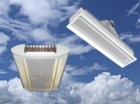Engineering elegance with chilled beams

Using chilled beams for comfort cooling enables engineers to exercise their imagination in creating energy-efficient solutions — as Wander ter Kuile explained to Ken Sharpe.
Chilled beams, both active and passive, make possible such elegant and energy-efficient engineering solutions for cooling buildings that one wonders if fan-coil units would ever have been such a popular method of air conditioning if chilled beams had been invented first.
That is the impression gained from Wander ter Kuile, Waterloo’s technical manager as he shares his enthusiasm for this technology.
‘Chilled beams,’ explains Wander ter Kuile, ‘operate with a chilled-water flow temperature of 14°C, which is inherently more energy-efficient than the 6°C that is typically used with fan-coil units. Indeed, such a high flow temperature might obviate the need for a chiller and certainly increases the viability of geothermal cooling, for example, where the temperature of the ground during a year may not rise above 12°C.’
Wander ter Kuile also emphasises to the simplicity of an active chilled beam compared with a fan-coil unit. Quite simply a chilled beam has no moving parts such as a fan in the space and nor does it have an air filter that needs changing regularly — unlike fan-coil units.
The driving force of an active chilled beam is a relatively small quantity of treated primary air that induces several times more secondary air from the room to flow though a chilled -water coil and back into the room. ‘No fan, and no air filters,’ he stresses. ‘And no fan means a much reduced possibility of noise issues, which is a key point in our negotiations with two hotel chains to provide air conditioning for guest rooms’
Nor is the temperature of the primary air particularly important as most of the cooling can be provided by the chilled water coil. Indeed, primary air can be supplied at 20°C, or even higher, through small nozzles in the beam to increase the entrainment of room air and maximise the effect of the chilled-water coil. At the other extreme, primary air can be supplied at 14°C through larger nozzles to reduce the effect of the cooling coil.
Wander ter Kuile explains that quite small quantities of primary air are required. 20 l/s of primary air inducing four times that volume of secondary air will provide a similar cooling capacity to a fan-coil unit supplying 200 l/s of air.
A common concern with chilled beams is their initial cost. Wander ter Kuile accepts that the initial cost of these terminal devices is higher than a fan-coil unit, but points out that the chilled-beam includes the grille and plenum box — costs which will anyway be incurred at a later stage with a project using fan-coil units. ‘There is an important benefit in a chilled beam being supplied with its grille and plenum box.’ says Wander ter Kuile, ‘The components will be matched, and the unit will do what it says on the box.’

Air-conditioning installations using chilled beams do not have to be huge. Wander ter Kuile has experience of installations with as few as 10 active beams, each 600 mm square, though he suggests that 20 beams is more realistically the lower limit. ‘Add in a 100 mm-diameter air duct and a self-contained chiller outdoors, and you have an effective air-conditioning system for, for example, refurbishing a small office building,’ he says. ‘Such a system,’ he elaborates, ‘ is an alternative to ceiling cassettes, which require a fresh-air supply to them and involve the complexities of refrigerant pipework if they are direct-expansion units.’
On a larger scale is the installation for Hope Hospital in Salford, with 56 active beams providing air conditioning in the pain-management centre.
The beams provide cooling and heating. They are all 300 mm long, mounted 2.7 m above the floor and from 1.8 to 3 m long to provide a total cooling capacity of 52 kW and heating of 39 kW. Primary air is supplied at 18°C and chilled water at 14°C flow and 17°C return. Water for heating is at a low 45°C, with return at 35°C.
Depending on the area being served, the beams in Hope Hospital are mounted flush with the suspended ceiling or supported independently from the soffit. The consulting engineer for the project was Faber Maunsell|AECOM.
An example of a larger project is the first phase of the 10-year staged development programme at Dublin Airport. Dublin Airport Authority specified that the building should be as energy efficient as possible to meet new regulations on energy use from the European Union. Helping to meet this requirement is the installation of 390 active chilled beams.
Waterloo worked closely with its Irish distributor, Ventac, and M&E contractor Lynskey Engineering to design this installation.
It is the potential of chilled beams to enable engineering creativity in a way not possible with split systems that enthuses Wander ter Kuile, but that does not mean that a chilled beams is an exotic product. Quite the contrary; he explains that they are a commodity product in many European countries — including France, Germany and Holland — and that Waterloo Air Products can deliver to order in a couple of weeks depending on the project requirements and quantities.









